The Featured Creatures collection provides in-depth profiles of insects, nematodes, arachnids and other organisms relevant to Florida. These profiles are intended for the use of interested laypersons with some knowledge of biology as well as academic audiences.
Introduction
Several native and introduced species of flies in the genus Hydrellia (Figure 1) are important because they feed on hydrilla (Hydrilla verticillata L.f. Royle), an invasive aquatic plant that has been classified as a Federal Noxious Weed. Hydrilla has invaded aquatic ecosystems in Florida and across the US. Larvae of Hydrellia spp. mine the leaves of hydrilla. In Florida, four species are associated with the invasive aquatic weed hydrilla: two native species and two species that were introduced for biological control of hydrilla. The native species are Hydrellia bilobifera Cresson and Hydrellia discursa Deonier. The introduced species are Hydrellia pakistanae Deonier and Hydrellia balciunasi Bock.
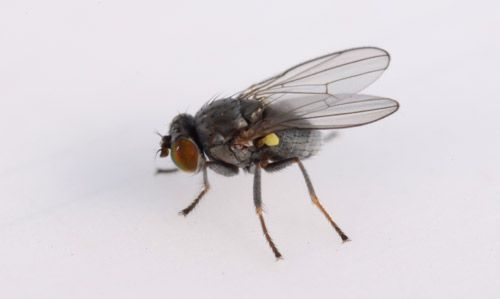
Credit: Lyle J. Buss, University of Florida
Distribution
Hydrellia bilobifera is known to feed on hydrilla (Balciunas and Minno 1985), although it also feeds on other aquatic weeds (Center et al. 1998). It is not known if Hydrellia discursa also feeds on hydrilla, but the species is found often in association with hydrilla so the weed is likely to act as a food source (Cofrancesco et al. 2005c). In contrast to the introduced species, Hydrellia bilobifera causes minimal leaf damage but mines the stems.
The Asian hydrilla leaf mining fly, Hydrellia pakistanae, was introduced to Florida in 1987 after being collected in India in 1985. The native range of Hydrellia pakistanae includes India, Pakistan and China (McCann et al. 1996). The Australian hydrilla leaf mining fly, Hydrellia balciunasi, was introduced to Florida in 1989 after being collected in Australia in 1982 and taken to Florida for evaluation as a biological control agent and for mass rearing. Releases of Hydrellia pakistanae resulted in successful establishment of the fly in Florida as well as in other southeastern states (Cofrancesco et al. 2005a).
Hydrellia balciunasi failed to establish in Florida and is found in low numbers in only a couple of water bodies in Texas (Cofrancesco et al. 2005b). Thanks to natural dispersal of the flies, most of the hydrilla-infested water bodies in Florida have established populations of Hydrellia pakistanae. However, hydrilla is still a serious problem in many water bodies. The lack of control provided by Hydrellia pakistanae in these instances is likely due to low densities of the insect in the field because of various abiotic and biotic factors (Wheeler and Center 2001, Cuda et al. 2008) such as parasitism by the native wasp Trichopria columbiana (Ashmead) (Coon et al. 2004).
Description
Eggs
Eggs are glossy, white, around 0.5 mm in length, and look similar to a grain of rice (Figure 2). Under magnification, the eggs exhibit longitudinal ridges, which are characteristic of the genus. Eggs are laid individually on hydrilla or other aquatic vegetation, and a female may lay hundreds of eggs throughout her life span (Cofrancesco et al. 2005a).
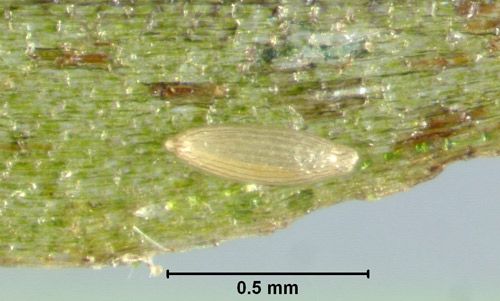
Credit: Lyle J. Buss, University of Florida
Larvae
Larvae are white, soft bodied and difficult to differentiate among species (Cofrancesco et al. 2005c). There are three instars. Each instar increases in size from around 0.5 to 2.0 mm in length and 0.2 to 0.5 mm in width. The color changes depending upon nutritional status; feeding larvae are often green due to chlorophyll in the hemolymph. After hatching, larvae burrow into the plant tissue of the hydrilla leaf, forming burrows or mines (Figure 3). The mouthparts consist of a pair of hooks to rasp away the inner tissue of the leaf (Cofrancesco et al. 2005c). Each larva will feed on about 12 leaves before it is ready to pupate (Cofrancesco et al. 2005a). When it is ready to pupate, the late third instar uses its needle-like modified spiracular peritremes (i.e., the area around the spiracle) to pierce the tissue of the stem. This attachment provides oxygen to the pupae (Deonier 1971).
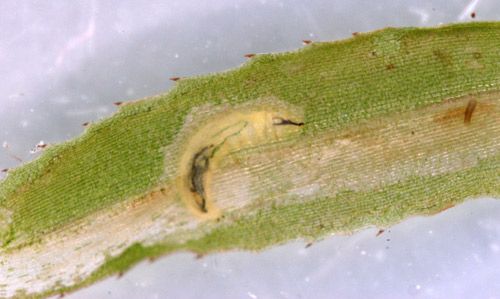
Credit: Lyle J. Buss, University of Florida
Pupae
Pupae are found within a cigar-shaped puparium that is formed from the last larval cuticle and looks like the leaf bud of hydrilla (Figure 4; Grodowitz et al. 1997). The puparia are about 28 mm long and 0.75 mm wide and initially are transparent. At this point, the puparia appear green in color, due to the plant material ingested by the larvae. As the pupa develops, the puparium turns from green to brown. The puparium is attached to a leaf axil and is filled with air.
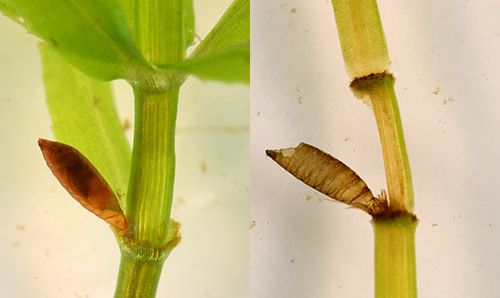
Credit: Lyle J. Buss, University of Florida
Adults
The adult emerges from the puparium and floats to the water's surface in an air bubble. In Hydrellia balciunasi, this occurs between 2 and 4 pm (Buckingham et al. 1991). The adult flies are about 1.5 mm to 2.0 mm in length and resemble small house flies (Figure 1). The adults have shiny golden heads with green eyes, dark antennae, and light-colored maxillary palps. Males can be distinguished from the females by the presence of two lobes at the end of the abdomen (Center et al. 1998). The two introduced species are not strong fliers and prefer hopping across the water surface to rest on emergent vegetation. The introduced species also are difficult to separate and differentiate from the native Hydrellia species. However, there are slight differences in the adult genitalia that a trained professional can distinguish (Grodowitz et al.1993).
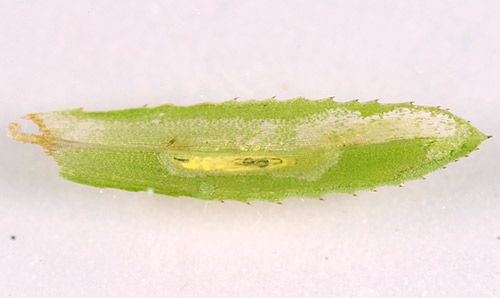
Credit: Lyle J. Buss, University of Florida
Life Cycle/Biology
Hydrellia spp. undergo complete metamorphosis. Life stages include the egg, three larval instars, the pupa and the adult. After 3 to 4 days, the larvae hatch from the eggs. The larval stage lasts about two weeks before pupation and the development time depends upon the ambient temperature. Pupae develop within the puparium over a period of 6 to 15 days, and adults live approximately 10 to 20 days. Adults of Hydrellia balciunasi mate within two hours of emergence (Buckingham et al. 1991). The entire life cycle of Hydrellia spp. ranges from 25 to 30 days. Hydrellia pakistanae overwinters as first and second instars in hydrilla stems near the water surface (Harms and Grodowitz 2011).
Host Plants
The imported hydrilla leaf mining flies were first collected from hydrilla in their respective countries of origin. Laboratory studies and field surveys demonstrated that both imported hydrilla leaf mining fly species are specific to hydrilla. Although the females may lay their eggs on other aquatic plants, larvae prefer to feed on hydrilla.
In host-specificity testing, Hydrellia pakistanae females oviposited on all 29 test plant species, as well as inert objects, but preferred hydrilla (Buckingham et al. 1989). Larvae developed on five out of 51 plant species tested but only in low numbers (Buckingham et al. 1989). Curly leaf pondweed (Potamogeton crispus L.) supported larval development and produced the most adults but did not sustain subsequent generations (Buckingham et al. 1989). Of 19 aquatic plants examined from its native range in Pakistan, Hydrellia pakistanae developed only on hydrilla and Potamogeton spp., including Potamogeton crispus, Potamogeton indicus Roxb., and Potamogeton perfoliatus L. (Baloch et al. 1980). Development on Potamogeton spp. was limited, and larvae moved onto hydrilla if given the choice (Baloch et al. 1980).
In contrast, Hydrellia balciunasi appears to be more host specific. Only one other plant species (Potamogeton crispus) out of 14 in a no-choice test and one out of 27 in a multi-choice test supported larval development (Buckingham et al. 1991). In the field in its native range in Australia, larvae were found on 24 aquatic plant species, but 97% of the specimens were collected from hydrilla (Balciunas and Burrows 1996).
Damage
Larvae of the hydrilla leaf mining fly are the damaging stage. Larvae are leaf miners that burrow into the leaf and feed on the inner tissue of the leaf. The mining removes almost all the leaf tissue resulting in transparent leaves. Hydrellia pakistanae has been shown to reduce total biomass (30% reduction), tuber biomass (60% reduction) and tuber number (55% reduction) in tank tests (Doyle et al. 2002). Although each fly larva will consume only about 12 leaves, the reduction in photosynthetic capability (Doyle et al. 2002) and the increased chance of pathogen transmission (Balciunas et al. 2002) are detrimental, especially when the larvae feed in great numbers. A high level of damage by the feeding larvae (70-90%) results in approximately 60% loss in photosynthetic capacity.
The reduction in leaf area also reduces the buoyancy of the plant, and when larval feeding damage is high, the plant will die and sink. Patches of hydrilla with intense feeding damage turn brown (Cofrancesco et al. 2005a). In most natural aquatic ecosystems in the US, hydrilla is considered undesirable either for aesthetic or practical reasons, and tremendous effort and resources are directed toward controlling the plant. Feeding damage by Hydrellia pakistanae is thought to have a significant impact on hydrilla biomass and tuber density. Therefore, many releases have been made across the US in an attempt to control this invasive plant without the need for excessive herbicide applications. However, the density of flies at field sites usually remains low, resulting in limited damage and control, perhaps due to population declines during the winter as well as other factors, such as predation and parasitism (Wheeler and Center 2001, Cuda et al. 2008). A known parasite of Hydrellia flies is the parasitic wasp Trichopria columbiana (Ashmead).
Combining the fly releases with other treatments as part of an integrated pest management program is likely to be more effective than the fly damage alone at reducing hydrilla biomass. A combination of herbivory by Hydrellia pakistanae and a plant disease-causing pathogen may facilitate plant pathogen transmission and increase plant damage and could provide a sustainable alternative to conventional herbicide-only control efforts. Studies have demonstrated compatibility of the hydrilla leaf mining fly with other control organisms, such as plant pathogens isolated from hydrilla (Shabana et al. 2003).
Importance as a Biological Control Agent
Hydrellia pakistanae is well established in Florida and is found in most water bodies where hydrilla is present. The Asian hydrilla leaf mining fly was collected in India and brought into quarantine in the US in 1985 (Buckingham et al. 1989). Over 3 million individuals were released between 1987 and 1997 in seven states: Florida, Mississippi, Alabama, Louisiana, Georgia, California, and Texas (Center et al. 1997). Early releases in Florida between 1987 and 1989 of over 37,000 individuals at 12 sites failed to lead to established populations (Center et al. 1997). Alterations to the rearing and release protocol, including maintaining the colony in the laboratory for a shorter time period and releasing greater numbers of larvae into cages for protection, as opposed to releasing smaller numbers of unprotected eggs, resulted in establishment after later releases (Center et al. 1997).
In southern Florida, 70% of the release sites showed establishment (Center et al. 1997). Dispersal to other sites with hydrilla also has been recorded. For example, high numbers of Hydrellia pakistanae were collected in the Miami Canal in 1993, with the nearest release site being over 15 km away (Center et al. 1997). In 1997, Hydrellia pakistanae was found to be established from northern Alabama to southern Florida, with records in Texas, Alabama, Georgia, and Florida (Center et al. 1997). The effect on hydrilla varies between sites, but as of 1992, 39% of surveyed release sites had well-established populations and substantial declines in hydrilla (Grodowitz et al. 1993). However, a decline in hydrilla also was observed in 36% of surveyed sites that had no or limited establishment. While Hydrellia pakistanae established well on dioecious hydrilla it failed to establish on monoecious hydrilla suggesting that the host plant genotype is important for biological control agent success (Bownes 2015).
Hydrellia balciunasi, the Australian hydrilla leaf mining fly, was collected in Queensland, Australia, in 1985, and brought into quarantine in the US in 1988 (Balciunas and Burrows 1996, Grodowitz et al. 1997). It was hoped that, being from Australia, Hydrellia balciunasi would be better suited to the climate in the US than Hydrellia pakistanae and establish further north (Buckingham et al. 1988). The species was released in Florida in 1989 and in Texas in 1991 (Grodowitz et al. 1997). Between 1989 and 1997, over 280,000 individuals were released at seven sites in Florida and four in Texas (Grodowitz et al. 1997).
In 1997, a survey recorded definite establishment (adults collected for four consecutive months) at only one site in Texas, Sheldon Reservoir (Harris County), and none in Florida (Grodowitz et al. 1997). The site corresponded to the site with the second highest releases (76,000 individuals), whereas the most released at any one site in Florida was 20,000 individuals (Grodowitz et al. 1997). Despite many releases at that site, the numbers of adults remained low and only 5% damage to hydrilla was recorded at peak fly densities in 1992 (Grodowitz et al. 1997). Failure of this insect to establish has been attributed to several factors including competition with Hydrellia pakistanae, incompatibility with the US strains of hydrilla, parasitism by the native wasp Trichopria columbiana (Ashmead), and inbreeding due to mass rearing (Grodowitz et al. 1997).
Monitoring and Management
Several methods can be used to monitor Hydrellia fly activity. First, hydrilla can be collected and the leaves examined for the characteristic damage caused by the larvae (Figure 5; Grodowitz et al. 1997). The larvae and pupae also may be detected under a light microscope. However, this method does not allow for identification to species. To identify the flies to species, it is necessary to either rear the immature stages to adults or collect adults in the field (Grodowitz et al. 1997). One of the best methods to collect adults in the field involves the use of a specially designed hand-held vacuum (Cofrancesci et al. 2005). Berlese funnels also can be used to extract larvae and adults from plant material (Grodowitz et al. 1997; Cofrancesco et al. 2005).
In a few specific situations where the presence of hydrilla is desired, e.g., in ponds or fishing lakes, the flies may need to be controlled to prevent damage to the plant. Researchers conducting experiments with hydrilla also may need to chemically or physically exclude Hydrellia flies or other hydrilla-attacking insects in order to produce suitable plant material for their investigations.
The authors would like to acknowledge funding provided by the USDA NIFA RAMP Grant 2010-02825 that helped pay for the production of this article. The authors would like to acknowledge the reviewers that provided feedback on an early draft of the article.
Selected References
Balciunas JK, Burrows DW. 1996. "Distribution, abundance, and field host-range of Hydrellia balciunasi Bock (Diptera: Ephydridae), a biological control agent for the aquatic weed, Hydrilla verticillata (L.f.) Royle". Australian Journal of Entomology 35: 125–130.
Balciunas JK, Grodowitz MJ, Cofrancesco AF, Shearer JF. 2002. "Hydrilla". In Van Driesche R et al. 2002 Biological Control of Invasive Plants in the Eastern United States, USDA Forest Service Publication FHTET-2002-04, 413P. (1 June 2022).
Balciunas JK, Minno MC. 1985. "Insects damaging hydrilla in the USA". Journal of Aquatic Plant Management 23: 77–83.
Baloch GM, Sana-Ullah, Ghani MA. 1980. "Some promising insects for the biological control of Hydrilla verticillata in Pakistan". Tropical Pest Management 26: 194–200.
Bownes A. 2015. A comparison of host range and performance of congeneric leaf-mining flies, Hydrellia pakistanae (Diptera: Ephydridae) and Hydrellia sp., two candidate biological control agents for the South African biotype of Hydrilla verticillata (Hydrocharitaceae). Biological Control 84: 44-52.
Buckingham GR. 1988. "Reunion in Florida - hydrilla, a weevil and a fly". Aquatics 10: 19–25.
Buckingham GR, Okrah EA, Christian-Meier M. 1991. "Laboratory biology and host range of Hydrellia balciunasi (Diptera: Ephydridae)". Entomophaga 36: 575–586.
Buckingham GR, Okrah EA, Thomas MC. 1989. "Laboratory host range tests with Hydrellia pakistanae (Diptera: Ephydridae), an agent for biological control of Hydrilla verticillata (Hydrocharitaceae)". Environmental Entomology 18: 164–171.
Center TD, Dray FA, Vandiver VV. 1998. "Biological control with insects: the hydrilla leaf mining fly". University of Florida, Cooperative Extension Service, Institute of Food and Agricultural Sciences. Fact Sheet AGR 83. (14 December 2021).
Center TD, Grodowitz MJ, Cofrancesco AF, Jubinsky G, Snoddy E, Freedman JE. 1997. "Establishment of Hydrellia pakistanae (Diptera: Ephydridae) for the biological control of the submersed aquatic plant Hydrilla verticillata (Hydrocharitaceae) in the Southeastern United States". Biological Control 8: 65–73.
Cofrancesco A, Grodowitz M, Center T, Balciunas J. 2005b. - "Australian hydrilla leaf mining fly". Noxious and Nuisance Plant Management Information Systems, Engineer Research and Development Center. (5 July 2017).
Cofrancesco A, Grodowitz M, Center T, Balciunas J. 2005c. "Hydrellia larvae". Noxious and Nuisance Plant Management Information Systems, Engineer Research and Development Center. (5 July 2017).
Coon BR, Harms NE, Cuda JP, Grodowitz MJ. 2014. "Laboratory biology and field population dynamics of Trichopria columbiana (Hymenoptera: Diapriidae), an acquired parasitoid of two hydrilla biological control agents". Biocontrol Science and Technology 24:1243–1264.
Cuda JP, Charudattan R, Grodowitz MJ, Newman RM, Shearer JF, Tamayo ML, Villegas B. 2008. "Recent advances in biological control of submersed aquatic weeds". Journal of Aquatic Plant Management 46: 15–32.
Deonier DL. 1971. "A systematic and ecological study of nearctic Hydrellia (Diptera: Ephydridae)". Smithsonian Contributions to Zoology 68: 1–138.
Doyle RD, Grodowitz MJ, Smart RM, Owens C. 2002. "Impact of herbivory by Hydrellia pakistanae (Diptera: Ephydridae) on growth and photosynthetic potential of Hydrilla verticillata". Biological Control 24: 221–229.
Flanders RV. 2003. "Field release of the nonindigenous leafmining flies". Environmental Assessment, USDA APHIS. (14 December 2021).
Grodowitz MJ, Center TD, Cofrancesco AF, Freedman JE. 1997. "Release and establishment of Hydrellia balciunasi (Diptera: Ephydridae) for the biological control of the submersed aquatic plant Hydrilla verticillata (Hydrocharitaceae) in the United States". Biological Control 9: 15–23.
Grodowitz J, Center T, Snoddy E, Rives E. 1993. "Status of the release and establishment of insect biocontrol agents of hydrilla". Pages 93–98. In Proceedings of the 27th Annual Meeting of Aquatic Plant Control Research Program, 16-19th November 1992. Bellevue, Washington, Miscellaneous paper A-93-2, U.S. Army Engineer Waterways Experiment Station, Vicksburg, Mississippi.
Harms NE, Grodowitz MJ. 2011. "Overwintering biology of Hydrellia pakistanae, a biological control agent of hydrilla". Journal of Aquatic Plant Management 49: 114–117.
McCann JA, Arkin L, Williams JD. 1996. "Nonindigenous aquatic and selected terrestrial species of Florida: status, pathway and time of introduction, present distribution, and significant ecological and economic effects". National Biological Service, Southeastern Biological Science Center. (14 December 2021).
Shabana YM, Cuda JP, Charudattan R. 2003. "Combining plant pathogenic fungi and the leaf mining fly, Hydrellia pakistanae, increases damage to hydrilla". Journal of Aquatic Plant Management 41: 76–81.
Wheeler GS, Center TD. 2001. "Impact of the biological control agent Hydrellia pakistanae (Diptera: Ephydridae) on the submersed aquatic weed Hydrilla verticillata (Hydrocharitaceae)". Biological Control 21: 168–181.